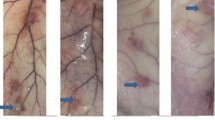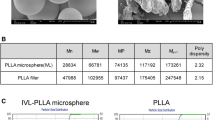Abstract
Although a wide range of materials has been used as implants in reconstructive or cosmetic surgery, many implant materials proved to be of limited usefulness due to lack of stability or result in host immune response. The purpose of this study is to explore a new autogenous injectable soft-tissue filler derived from hair and evaluate the possible use of this potential filling agent. Hair fibers after bleaching were processed into different size particles by a ball mill or hair keratin gel, respectively. The microstructure of material was observed under electron microscopy. General toxic tests in vitro or in vivo include MTT assay, acute toxicity, and the micronucleus were used to evaluate the biocompatibility of this material. Animal subcutaneous implant models were employed to investigate the immune reaction, absorption, and maintenance of the augmentation effect. Hair-derived material after processing showed an intrinsic capacity with preferable fluidity and glutinousness for injection. General toxic evaluation revealed a good biocompatibility and an absence of cytotoxicity or mutagenicity. Animal subcutaneous implant models did not show local or systemic adverse reactions in the observation period. Hair fiber particles showed preferable augmentation effect which preserved at least 50% of original volume during the observation period compared to hair keratin gel. The optimal size of the particle is about 120 μm. The autogenous hair material directly processed by the ball mill after bleaching is easy to obtain and shows biocompatibility and biodegradability well. It may become a prospective filling agent in reconstructive or cosmetic surgery.








Similar content being viewed by others
References
Bucky LP, Kanchwala SK (2007) The role of autologous fat and alternative fillers in the aging face. Plast Reconstr Surg 120(6 Suppl):89S–97S
Alonso L, Fuchs E (2006) The hair cycle. J Cell Sci 119(Pt 3):391–393
Rogers GE (2004) Hair follicle differentiation and regulation. Int J Dev Biol 48(2–3):163–170
Ohkubo N, Hirose H, Matsuda H et al (1986) Evaluation of a new antithrombogenic polyurethane–polysiloxane complex biomaterial. ASAIO Trans 32(1):193–197
Katoh K, Tanabe T, Yamauchi K (2004) Novel approach to fabricate keratin sponge scaffolds with controlled pore size and porosity. Biomaterials 25(18):4255–4262
Tachibana A, Furuta Y, Takeshima H, Tanabe T, Yamauchi K (2002) Fabrication of wool keratin sponge scaffolds for long-term cell cultivation. J Biotechnol 93(2):165–170
Kaakedjian G, Taylor P (1997) Hair as a filler material for reconstructive or cosmetic surgery. Plast Reconstr Surg 99(2):443–447
Uysal A, Ulusoy MG, Sungur N et al (2006) Combined use of hair and fibrin glue for soft tissue augmentation: experimental study. Aesthet Plast Surg 30(4):469–473
Sierpinski P, Garrett J, Ma J et al (2008) The use of keratin biomaterials derived from human hair for the promotion of rapid regeneration of peripheral nerves. Biomaterials 29(1):118–128
Li Y, Reca RG, Atmaca-Sonmez P et al (2006) Retinal pigment epithelium damage enhances expression of chemoattractants and migration of bone marrow-derived stem cells. Invest Ophthalmol Vis Sci 47(4):1646–1652
ISO 10993–5, Biological evaluation of medical devices-Part 5:Tests for in vitro cytotoxicity.
Mahmoudi M, Simchi A, Milani AS, Stroeve P (2009) Cell toxicity of superparamagnetic iron oxide nanoparticles. J Colloid Interface Sci 336(2):510–518
MacGregor JT, Wehr CM, Gould DH (1980) Clastogen-induced micronuclei in peripheral blood erythrocytes: the basis of an improved micronucleus test. Environ Mutagen 2(4):509–514
Marler JJ, Guha A, Rowley J et al (2000) Soft-tissue augmentation with injectable alginate and syngeneic fibroblasts. Plast Reconstr Surg 105(6):2049–2058
Fetttransplantation FN, Chir Kongr Verhandl Dsch Gesellch Chir, 1893. 22:66
Eppley BL, Dadvand B (2006) Injectable soft-tissue fillers: clinical overview. Plast Reconstr Surg 118(4):98e–106e
Rice RH, Wong VJ, Pinkerton KE, Sundberg JP (1999) Cross-linked features of mouse pelage hair resistant to detergent extraction. Anat Rec 254(2):231–237
Tachibana A, Kaneko S, Tanabe T, Yamauchi K (2005) Rapid fabrication of keratin-hydroxyapatite hybrid sponges toward osteoblast cultivation and differentiation. Biomaterials 26(3):297–302
Conflict of interest statement
The authors have no conflicts of interest.
Author information
Authors and Affiliations
Corresponding author
Rights and permissions
About this article
Cite this article
Ma, J., Zhang, J., Ma, X.J. et al. Evaluation of biocompatibility and biodegradability of a new auto-derived injectable soft tissue filler: a preliminary report. Eur J Plast Surg 34, 479–486 (2011). https://doi.org/10.1007/s00238-011-0565-2
Received:
Accepted:
Published:
Issue Date:
DOI: https://doi.org/10.1007/s00238-011-0565-2




